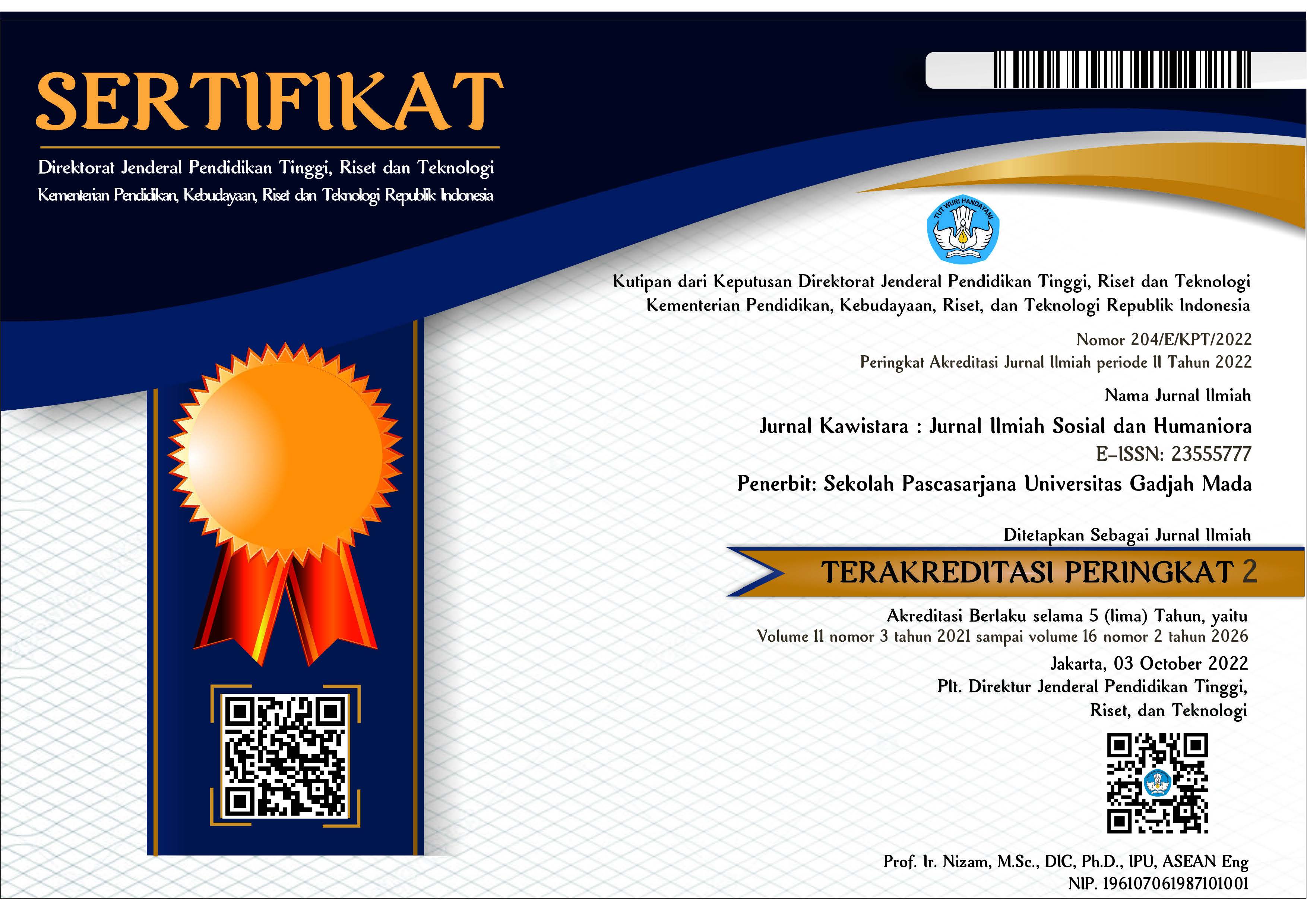Hyperpersonal Communication in Sexual Fantasies: A Study on Users of Paid Video Call Sex Services in Indonesia
Muhammad Alzaki Tristi(1*), Dian Arymami(2)
(1) Universitas Gadjah Mada
(2) Universitas Gadjah Mada
(*) Corresponding Author
Abstract
Keywords
Full Text:
PDFReferences
Ann Liebert, M., & Cooper, A. (1998). Sexuality and the Internet: Surfing into the New Millennium. In CyberPsychology & Behavior (Vol. 1, Issue 2).
Ayu, I. S., & Erianjoni, E. (2023). Video Call Sex (VCS) Berbayar Pilihan Remaja Kota Padang Dalam Pelampiasan Hasrat. Jurnal Perspektif, 6(1), 9–17.
Banks, J., & Van Ouytsel, J. (2020). Cybersex with human-and machine-cued partners: gratifications, shortcomings, and tensions. Technology, Mind, and Behavior, 1(1), 1–13.
Barrault, S., Hegbe, K. G., Bertsch, I., & Courtois, R. (2016). Relation entre les événements de vie traumatiques de l’enfance, le trouble de personnalité borderline et les conduites cybersexuelles problématiques. Psychotropes, 22(3), 65–81.
Bell, D. (2006). An introduction to cybercultures. Routledge.
Berger, C. R., & Roloff, M. E. (2019). Interpersonal communication. In An integrated approach to communication theory and research (pp. 277–292). Routledge.
Carnes, P. J., Delmonico, D. L., & Griffin, E. (2009). In the shadows of the net: Breaking free of compulsive online sexual behavior. Simon and Schuster.
Cooper, A. L. (1998). Sexuality and the Internet: Surfing into the new millennium. CyberPsychology & Behavior, 1(2), 187–193.
Das, D., Bose, P., Ruaro, N., Kruegel, C., & Vigna, G. (2021). Understanding Security Issues in the NFT Ecosystem. http://arxiv.org/abs/2111.08893.
Delmonico, D., Griffin, E., & Moriarty, J. (2001). Cybersex unhooked: A workbook for breaking free of compulsive online sexual behavior. Gentle Path.
Drejer, C., Riegler, M. A., Halvorsen, P., Johnson, M. S., & Baugerud, G. A. (2024). Livestreaming technology and online child sexual exploitation and abuse: A scoping review. Trauma, Violence, & Abuse, 25(1), 260–274.
Freud, S. (1927). Fetishism.(J. Strachey, Trans.) In The complete psychological works of Sigmund Freud (Vol. XXI, pp 147-157). London: Hogarth and the Institute of Psychoanalysis.
Griffiths, M. (2000). Excessive Internet Use: Implications for Sexual Behavior (Vol. 3, Issue 4). Mary Ann Liebert, Inc.
Griffiths, M. D. (2012). Internet sex addiction: A review of empirical research. Addiction Research & Theory, 20(2), 111–124.
Hertlein, K. M., & Stevenson, A. (2010). The Seven" As" Contributing to Internet-Related Intimacy Problems: A Literature Review. Cyberpsychology, 4(1).
ildawati, H. (2018). Seks Onlen, Media Sosial, dan Gender. Emik, 1(1), 37–52.
Irawanto, B. (2017). Mereguk Kenikmatan Di Dunia Maya: Virtualitas Dan Penubuhan Dalam Cybersex. Jurnal Kawistara, 7(1), 30–40.
Juditha, C. (2021). The Communication Network of Online Prostitution in Twitter. Jurnal ASPIKOM, 6(1), 13–28.
Karaian, L. (2024). Plastic fantastic: Sex robots and/as sexual fantasy. Sexualities, 27(3), 633–652.
Khakim, M., & Novianto, W. T. (2019). Criminal Law Policy Formulation to Prevent Cybersex Based on Civility Values. 3rd International Conference on Globalization of Law and Local Wisdom (ICGLOW 2019), 183–186.
McArthur, N., & Twist, M. L. C. (2017). The rise of digisexuality: Therapeutic challenges and possibilities. Sexual and Relationship Therapy, 32(3–4), 334–344.
Mitchell, R. W. (2021). High and Tight, Please: Self-explanations for Experiencing Short Haircuts as Erotic. Sexuality & Culture, 25(4), 1397–1427.
Naghdechi, L., Aadil, M., Kagadkar, F., & Levounis, P. (2021). Hacking the Human Sex Drive. Technological Addictions, 25.
Reeves, B., & Nass, C. (1996). The media equation: How people treat computers, television, and new media like real people. Cambridge, UK, 10(10).
Sharma, M. K., Anand, N., Thakur, P. C., N, S., Sahu, M., John, N., Tapatrikar, A., Biswas, A., Vishwakarma, A., & Singh, P. (2020). Pathways to Cybersex: Case-Report-Based Exploration. Journal of Psychosexual Health, 2(1), 96–99.
Shaw, D. F. (1997). Gay men and computer communication: A discourse of sex and identity in cyberspace. Virtual Culture: Identity and Communication in Cybersociety, 133–145.
Walther, J. B. (1996). Computer-mediated communication: Impersonal, interpersonal, and hyperpersonal interaction. Communication Research, 23(1), 3–43.
Walther, J. B. (2011). Theories of computer-mediated communication and interpersonal relations. The Handbook of Interpersonal Communication, 4, 443–479.
Wysocki, D. K. (1998). Let your fingers do the talking: Sex on an adult chat-line. Sexualities, 1(4), 425–452.
Young, K. S., Griffin-Shelley, E., Cooper, A., O’Mara, J., & Buchanan, J. (2013). Online infidelity: A new dimension in couple relationships with implications for evaluation and treatment. In Cybersex: The dark side of the force (pp. 59–74). Routledge.
Article Metrics
Refbacks
- There are currently no refbacks.
Copyright (c) 2024 Muhammad Alzaki Tristi; Dian Arymami

This work is licensed under a Creative Commons Attribution-ShareAlike 4.0 International License.
Jurnal Kawistara is published by the Graduate School, Universitas Gadjah Mada.











